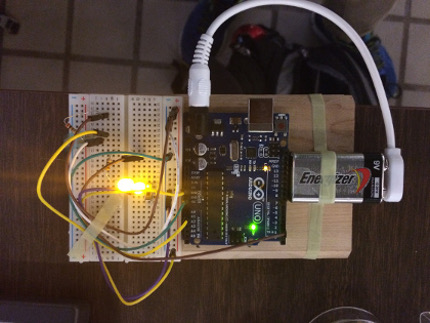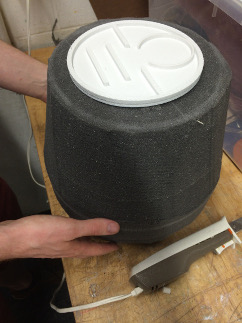Newton's Apple

Newton’s Apple is a physics toy designed to help kids ages 6-12 learn the basic principles of forces. Children can load the toy with special SD cards containing their favorite song. As they catch, roll, and interact with the toy, the music speeds up or slows down depending on their movements. Sensitivity and volume adjust through the eyes, which are hidden dials.
This project was done from January-May 2016. Previously, my projects were causal collaborations or were exclusively to learn a new skill. I wanted to do a project that was more serious, with real critiques and more akin to something done on the job.
Technical
Early prototypes and Ideas:


- A “noise pillow” where an Arduino, light, and bend sensor are set up to make weird noises depending on where and how hard people squish the pillow.
- An emoji plush toy, which is similar to the noise pillow.
- A “Physics Bop It” type game where an Arduino, lights, and various sensors are encased in a laser-cut cube. Players must do various actions such as changing the color of the light and moving the cube a certain way before time runs out.
Kids loved the plushness of our first two ideas, however our feedback indicated that the different tasks during the Physics Bop It were innovative and more engaging. We combined all three of the toys into our first iteration of Newton’s Apple.

The body was scuplted with an electric carving knife.

We prototyped with a thin, felt shell.
- An Arduino, combined with a speaker and potentiometer, control the toy.
- We used furniture foam for the body, as it was cheap and plentiful.
- A 3D printed case held the electronics in place.
Final iteration:

Our apple awaitng its photo shoot.
- We enlarged the entire toy to beach-ball size.
- We 3D printed an SD card mounting slot so people can easily add their own song.
- We replaced the original felt fabric for something more softer.
- Potentiometers integrated into the eyes change volume and sensitivity.
Result
Review
What went well:
- I’m better at idea generation and sorting. I’m better at generating criteria and choosing which idea to pursue.
- I gained real-world experience designing a toy that industry representatives scrutinized.
- Newton’s Apple feels like a premium product, especially with the thicker fabric.
Not so hot:
- Early on, I thought our ideas were subpar. I let my thoughts get the best of me, and didn’t work as hard as my teammates.
- Some of our early prototypes were too coarse, limiting the amount of constructive feedback judges gave.
- I didn’t communicate as frequently with teammates during later builds.
If I were to do the project again, I would add bluetooth and app support so people can play their favorite playlist instantly through the apple.
Many thanks to Barry Kurdowitz and team for running PDES 3711 Toy Product Design; it’s a superb class that anybody at UMN should take.